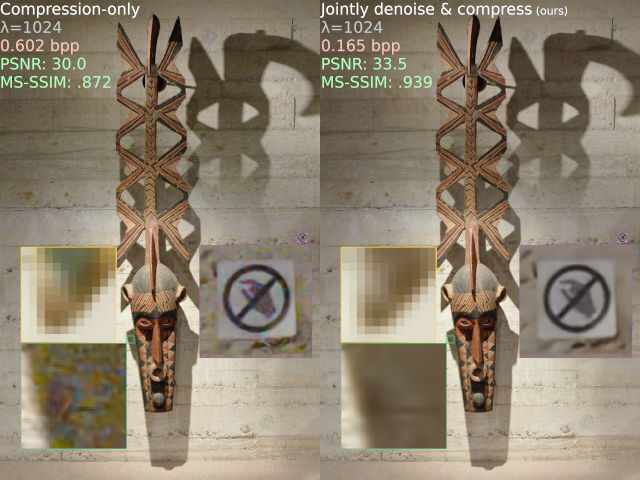Deep Learning
-
Body Part-Based Representation Learning for Occluded Person Re-Identification
 BPBReID, a part-based re-identification method using body part feature representations to compute to similarity between two person images.Jul 3, 2023
BPBReID, a part-based re-identification method using body part feature representations to compute to similarity between two person images.Jul 3, 2023 -
On the Importance of Denoising When Learning to Compress Images
 Image noise is not compressible nor desirable. Image compression models can be trained for joint denoising and compression resulting in a much better rate-distortion when encoding images which contain noise (and no adverse effect on clean images). Joint models outperform running a dedicated denoiser prior to compression without any of the complexity associated with denoising.Jan 31, 2023
Image noise is not compressible nor desirable. Image compression models can be trained for joint denoising and compression resulting in a much better rate-distortion when encoding images which contain noise (and no adverse effect on clean images). Joint models outperform running a dedicated denoiser prior to compression without any of the complexity associated with denoising.Jan 31, 2023
-
Scene Understanding with Time-of-Flight CamerasWe study embedded indoor scene understanding in order to obtain a privacy-friendly senior monitoring solution. Our solution makes use of Convolutional Neural Networks in order to fuse the spatial and reflective information given by a Time-of-Flight sensor.Mar 2, 2020
-
Deep Learning for Anomaly Detection in Industrial Vision
 In order to detect anomaly in an unsupervised scheme, an autoencoder is trained to reconstruct clean images out of defect-free images corrupted with synthetic noise. During inference an arbitrary (with or without anomaly) image is projected onto the normal space of images. The intensity of the residual map between the original image and its reconstruction estimates the likelihood of a region to be defective.Mar 2, 2020
In order to detect anomaly in an unsupervised scheme, an autoencoder is trained to reconstruct clean images out of defect-free images corrupted with synthetic noise. During inference an arbitrary (with or without anomaly) image is projected onto the normal space of images. The intensity of the residual map between the original image and its reconstruction estimates the likelihood of a region to be defective.Mar 2, 2020 -
An experimental study of the neuron-level mechanisms emerging during backpropagation-based training
 However deep and complex they may be, deep neural networks result from the repetition of a very simple building block: the neuron. Our work makes the bet that this key structural characteristic should be used to understand deep learning, and studies the following research question: could it be that during global, end-to-end SGD training of deep nets, neuron-level mechanisms emerge even though they have not been explicitly programmed?Mar 2, 2020
However deep and complex they may be, deep neural networks result from the repetition of a very simple building block: the neuron. Our work makes the bet that this key structural characteristic should be used to understand deep learning, and studies the following research question: could it be that during global, end-to-end SGD training of deep nets, neuron-level mechanisms emerge even though they have not been explicitly programmed?Mar 2, 2020
